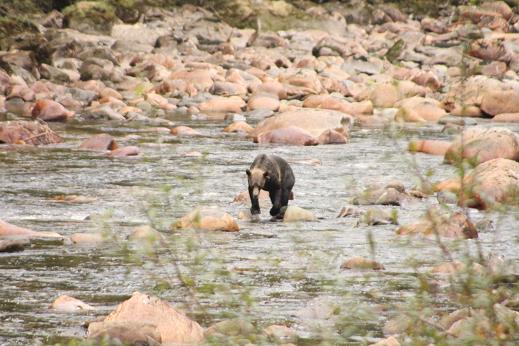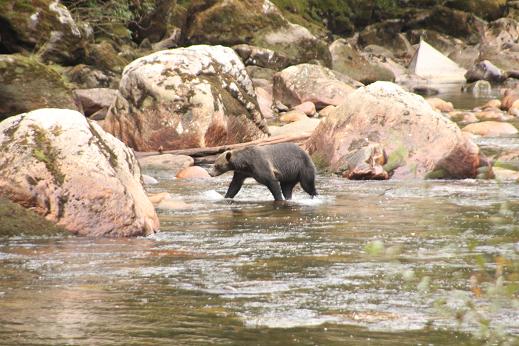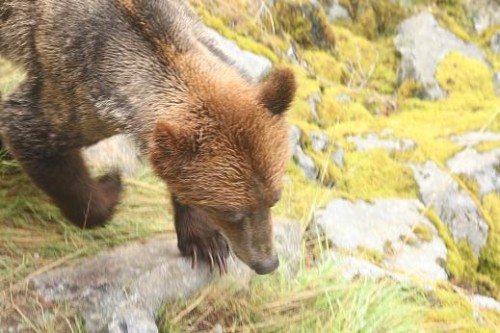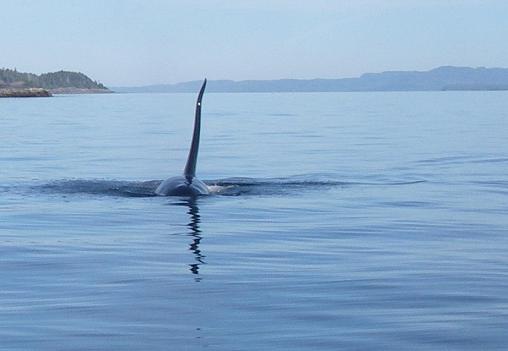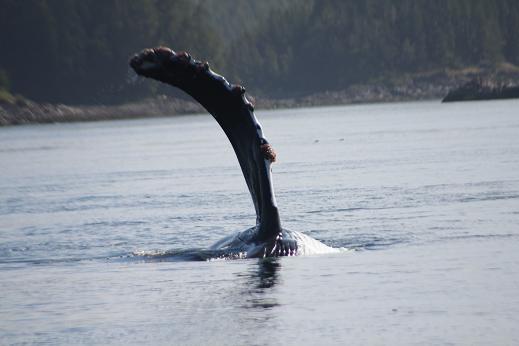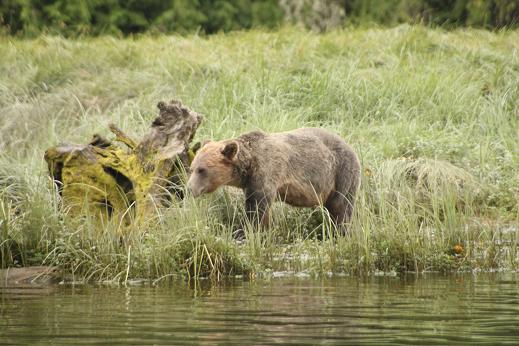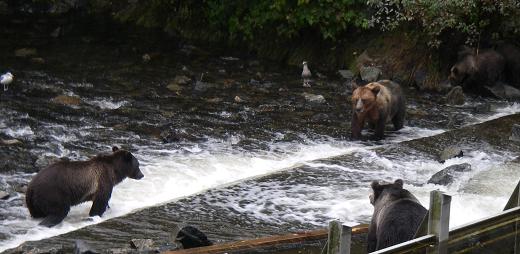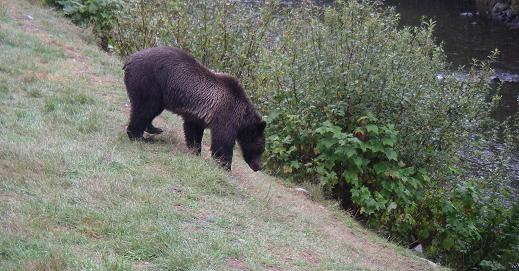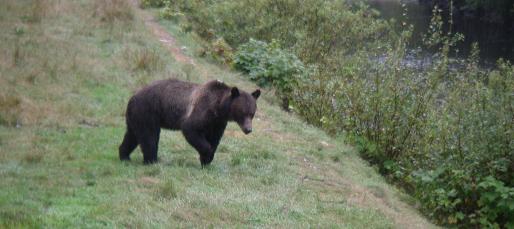On the extra day in camp we take a forty-five minute boat ride cross Knight Inlet through Thompson Sound to the Kakweikan River and spend a day with Trapper Rick. This river is located on the BC mainland and once there we travel by road to Rick’s cabin. Below the cabin on the river is a waterfall and a fish ladder that help the salmon by-pass the falls. (For more photos of Trapper’s cabin and surrounding area go to “Categories” on the left and select “River Day”.) This grizzly bear is working its way up river to the falls and the salmon….
Grizzly Bear and Wildlife Tour Blog
We offer an exceptional fly-in lodge for Grizzly Bear Watching and Whale Watching in British Columbia.
Learn about What’s happening at the Lodge, view our British Columbia’s Wildlife Report, read our Grizzly Bear Watching Blog and Whale Watching Blog. Learn more about a Day on the River Blog, see Our Tour Guide’s Photos & Blog and Photos from Our Guests.
Grizzly bears drink in a tidal river
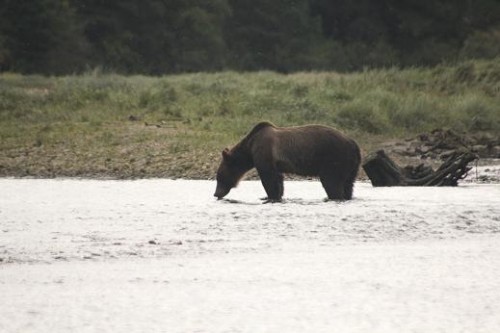 On Grizzly Bear Lodge’s wildlife tours during the hot days of July and August we frequently see grizzly bears in the water. The water in Knight Inlet’s Glendale estuary is a mixture of salt and fresh water which the grizzly bears often drink when the tide is going out. On a rising tide the surface water contains more salt so less drinking. It is better to have the grizzlies wading and swimming and cooling off in the water than moving into the shade away from our viewing.
On Grizzly Bear Lodge’s wildlife tours during the hot days of July and August we frequently see grizzly bears in the water. The water in Knight Inlet’s Glendale estuary is a mixture of salt and fresh water which the grizzly bears often drink when the tide is going out. On a rising tide the surface water contains more salt so less drinking. It is better to have the grizzlies wading and swimming and cooling off in the water than moving into the shade away from our viewing.
Grizzly bear claws
The grizzly bear claws are incredibly long, thick and powerful. The nails themselves can be 5 to 6 inches long. They use them to do more digging than any other bear species, digging dens, uprooting shrubs, shredding logs and stumps in search of insects and tubers, and turning over rocks on the beach. Also used to catch and hold salmon while they eat. This over head view is of a grizzly as it walks beneath the viewing stands on Knight Inlet’s Glendale River where we spend our viewing time after August 24th.
Killer Whale “Fin”
This is a little more graceful looking than yesterday’s post especially when it is coming toward the boat. The dorsal fin of a male killer whale is proportionately larger than that of a female. In adult males, the dorsal fin is tall and triangular. Reaching a height of up to 1.8 m (6 ft.) in a large adult male, it is the tallest dorsal fin of all cetaceans. And this photo is a good example of a large male.
Humpback Whale “Fin”
Spring Grizzly Bears Grazing
In the spring the grizzly bears we view on the lodges wilderness tours are primarily grazing or turning over rocks. They come down to the shores of Knight Inlet to eat the sedge grass, which is very high in protein. This sedge sustains them until the salmon enter the rivers of British Columbia’s coast in mid-August. The morning grizzly bear tour uses 18 to 20 foot boats to travel up Knight Inlet to the Glendale River where we transfer to smaller a boat that allow us to drift along the shore to watch and hear the bears eating. This flat bottom skiff also permits us to follow the grizzly bears up river as the tide rises.
Humpback Whales Visit
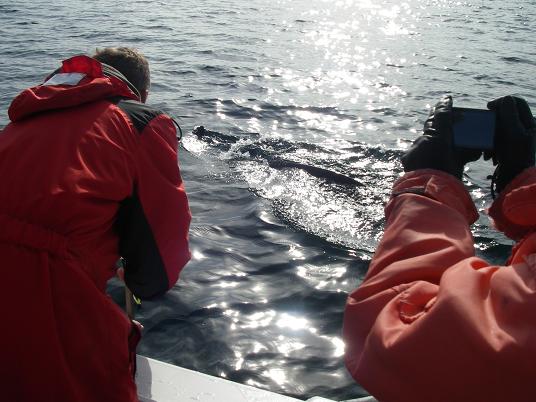
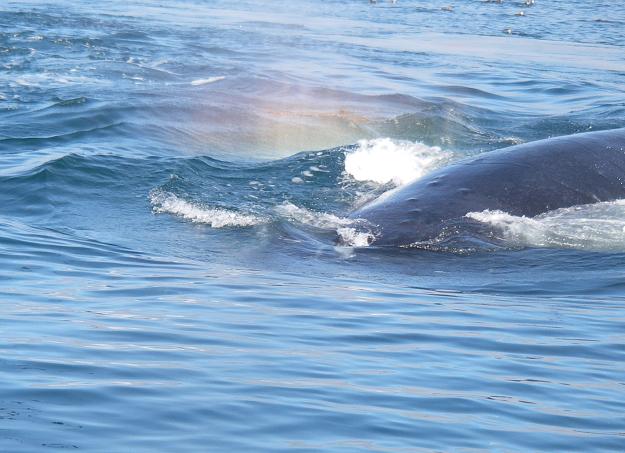 February 1st post shows our rest stop at Telegraph Cove on a whale watching day but it is not where we eat lunch. Our picnic lunch is normally in Blackfish Sound where we view most of the humpback whales. We either tie to a kelp bed or drift in open water if there is not much boat traffic. Drifting is my preferred lunch spot as we often have visitors. Unfortunately, in a good way, this frequently extends our lunch break as the whales demand pictures just as we have the picnic spread out and are eating. It is amazing how fast food in hand is replaced with cameras when a whale surfaces close to the boat.
February 1st post shows our rest stop at Telegraph Cove on a whale watching day but it is not where we eat lunch. Our picnic lunch is normally in Blackfish Sound where we view most of the humpback whales. We either tie to a kelp bed or drift in open water if there is not much boat traffic. Drifting is my preferred lunch spot as we often have visitors. Unfortunately, in a good way, this frequently extends our lunch break as the whales demand pictures just as we have the picnic spread out and are eating. It is amazing how fast food in hand is replaced with cameras when a whale surfaces close to the boat.
Grizzly approaching with caution 3 of 3
Grizzly approaching with caution 2 of 3
Grizzly approaching with caution 1 of 3
We are in the first viewing stand looking down the finger of land that links us to the second stand. This grizzly bear came up from the natural river and is crossing the track of road on its way to the pool holding the salmon waiting to enter the man made spawning channel. Its first glance is toward our position which is approximately 25 meters (yards) from the bear…
